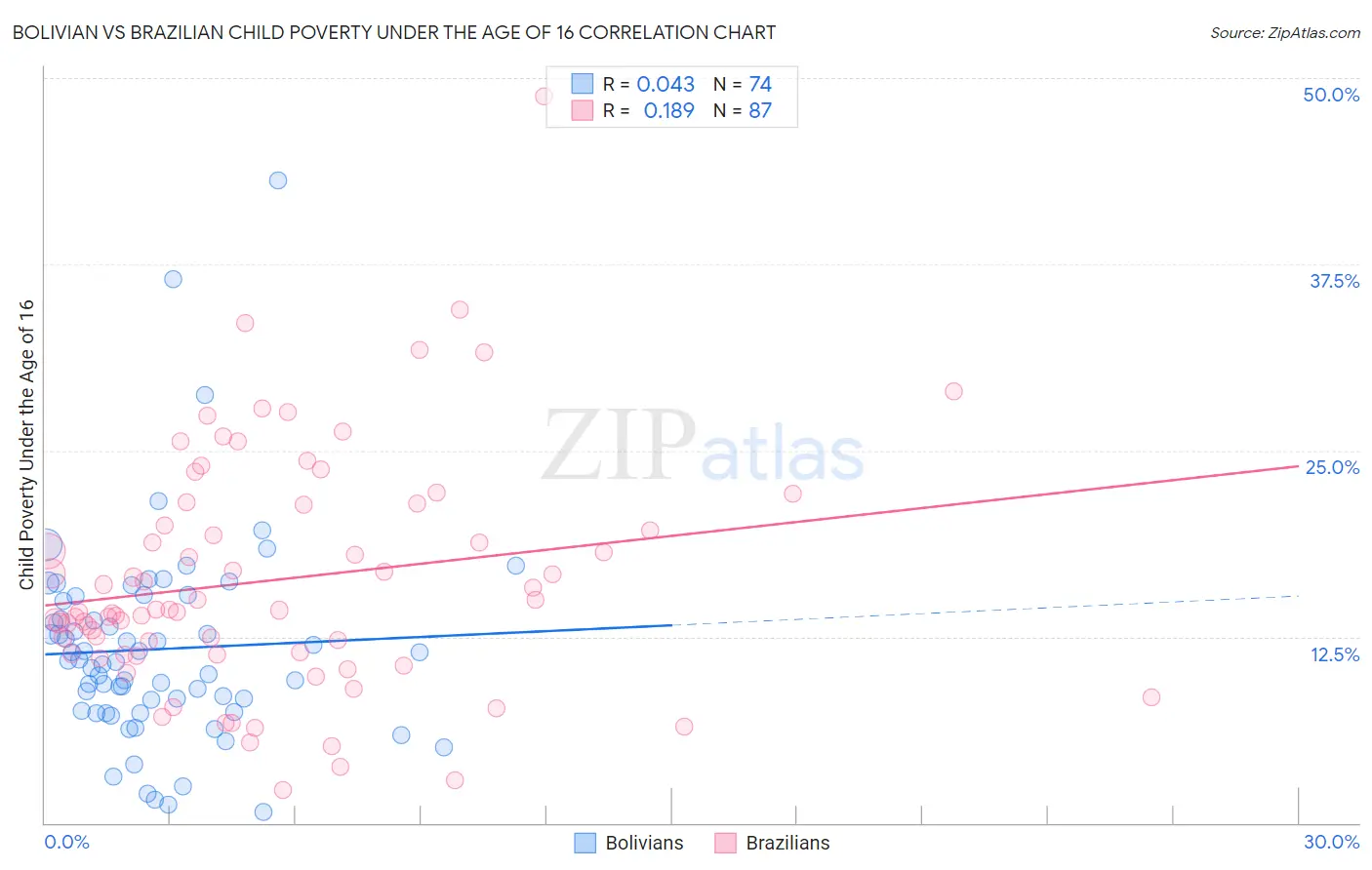Bolivian vs Brazilian Child Poverty Under the Age of 16
COMPARE
Bolivian
Brazilian
Child Poverty Under the Age of 16
Child Poverty Under the Age of 16 Comparison
Bolivians
Brazilians
13.2%
CHILD POVERTY UNDER THE AGE OF 16
99.8/ 100
METRIC RATING
26th/ 347
METRIC RANK
15.4%
CHILD POVERTY UNDER THE AGE OF 16
82.8/ 100
METRIC RATING
142nd/ 347
METRIC RANK
Bolivian vs Brazilian Child Poverty Under the Age of 16 Correlation Chart
The statistical analysis conducted on geographies consisting of 184,043,367 people shows no correlation between the proportion of Bolivians and poverty level among children under the age of 16 in the United States with a correlation coefficient (R) of 0.043 and weighted average of 13.2%. Similarly, the statistical analysis conducted on geographies consisting of 321,388,637 people shows a poor positive correlation between the proportion of Brazilians and poverty level among children under the age of 16 in the United States with a correlation coefficient (R) of 0.189 and weighted average of 15.4%, a difference of 16.6%.

Child Poverty Under the Age of 16 Correlation Summary
| Measurement | Bolivian | Brazilian |
| Minimum | 0.74% | 2.2% |
| Maximum | 43.1% | 48.8% |
| Range | 42.4% | 46.6% |
| Mean | 11.7% | 16.3% |
| Median | 10.8% | 14.3% |
| Interquartile 25% (IQ1) | 7.6% | 11.3% |
| Interquartile 75% (IQ3) | 14.9% | 21.3% |
| Interquartile Range (IQR) | 7.3% | 10.0% |
| Standard Deviation (Sample) | 6.9% | 8.0% |
| Standard Deviation (Population) | 6.8% | 8.0% |
Similar Demographics by Child Poverty Under the Age of 16
Demographics Similar to Bolivians by Child Poverty Under the Age of 16
In terms of child poverty under the age of 16, the demographic groups most similar to Bolivians are Immigrants from China (13.3%, a difference of 0.29%), Eastern European (13.2%, a difference of 0.42%), Latvian (13.2%, a difference of 0.50%), Assyrian/Chaldean/Syriac (13.3%, a difference of 0.53%), and Indian (Asian) (13.1%, a difference of 0.71%).
| Demographics | Rating | Rank | Child Poverty Under the Age of 16 |
| Immigrants | Japan | 99.8 /100 | #19 | Exceptional 13.0% |
| Okinawans | 99.8 /100 | #20 | Exceptional 13.1% |
| Immigrants | Eastern Asia | 99.8 /100 | #21 | Exceptional 13.1% |
| Maltese | 99.8 /100 | #22 | Exceptional 13.1% |
| Indians (Asian) | 99.8 /100 | #23 | Exceptional 13.1% |
| Latvians | 99.8 /100 | #24 | Exceptional 13.2% |
| Eastern Europeans | 99.8 /100 | #25 | Exceptional 13.2% |
| Bolivians | 99.8 /100 | #26 | Exceptional 13.2% |
| Immigrants | China | 99.8 /100 | #27 | Exceptional 13.3% |
| Assyrians/Chaldeans/Syriacs | 99.7 /100 | #28 | Exceptional 13.3% |
| Swedes | 99.7 /100 | #29 | Exceptional 13.3% |
| Turks | 99.7 /100 | #30 | Exceptional 13.4% |
| Danes | 99.7 /100 | #31 | Exceptional 13.4% |
| Tongans | 99.7 /100 | #32 | Exceptional 13.4% |
| Asians | 99.6 /100 | #33 | Exceptional 13.5% |
Demographics Similar to Brazilians by Child Poverty Under the Age of 16
In terms of child poverty under the age of 16, the demographic groups most similar to Brazilians are Icelander (15.4%, a difference of 0.070%), Immigrants from Hungary (15.5%, a difference of 0.19%), Immigrants from Peru (15.5%, a difference of 0.24%), Slovak (15.5%, a difference of 0.28%), and Slavic (15.4%, a difference of 0.34%).
| Demographics | Rating | Rank | Child Poverty Under the Age of 16 |
| Albanians | 88.6 /100 | #135 | Excellent 15.2% |
| Immigrants | Spain | 87.3 /100 | #136 | Excellent 15.3% |
| Peruvians | 87.2 /100 | #137 | Excellent 15.3% |
| Welsh | 87.2 /100 | #138 | Excellent 15.3% |
| Immigrants | Vietnam | 87.1 /100 | #139 | Excellent 15.3% |
| New Zealanders | 86.9 /100 | #140 | Excellent 15.3% |
| Slavs | 84.2 /100 | #141 | Excellent 15.4% |
| Brazilians | 82.8 /100 | #142 | Excellent 15.4% |
| Icelanders | 82.5 /100 | #143 | Excellent 15.4% |
| Immigrants | Hungary | 81.9 /100 | #144 | Excellent 15.5% |
| Immigrants | Peru | 81.7 /100 | #145 | Excellent 15.5% |
| Slovaks | 81.4 /100 | #146 | Excellent 15.5% |
| Immigrants | Kuwait | 80.5 /100 | #147 | Excellent 15.5% |
| Puget Sound Salish | 80.3 /100 | #148 | Excellent 15.5% |
| Israelis | 80.1 /100 | #149 | Excellent 15.5% |